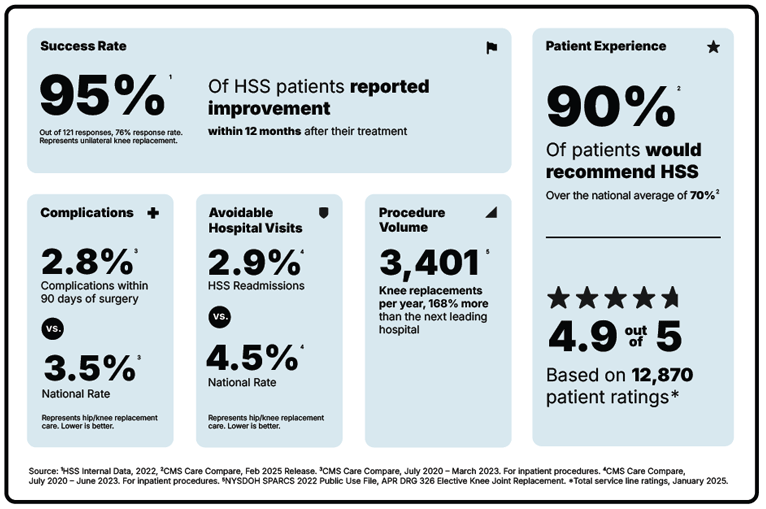Outpatient Knee Replacement Surgery: Frequently Asked Questions

Advancements in medical technology, technique and pain management have made it possible for many patients to have knee replacement on an outpatient basis. This offers many benefits to people who qualify for this procedure.
HSS performs more hip and knee replacements than any other hospital system in the world.
What is outpatient knee replacement surgery?
Outpatient knee replacement surgery, also called “rapid recovery knee replacement,” “same day knee replacement” or “ambulatory knee replacement,” is a total knee replacement procedure that allows qualified patients to return home on the same day of the operation, rather than stay overnight.
How do I know if can have an outpatient knee replacement?
Patients who are in good general health and are motivated are the best candidates. If you can answer "yes" to all of the below questions, you may be a candidate for outpatient knee replacement surgery.
- Are you generally healthy, with no significant medical conditions (for example, sleep apnea, history of heart attack, use of a pacemaker, etc.)?
- Are you motivated?
- Will you have support at home from a family member or friend after your discharge?
Consult one of our knee replacement surgeons to find out if you are an appropriate candidate for ambulatory joint replacement. All patients in the ambulatory joint replacement surgery program are evaluated by both the orthopedic surgeon and our multidisciplinary team. HSS joint replacement specialists perform a thorough evaluation of each patient’s individual circumstance in order to determine their eligibility for same-day knee replacement surgery.
In some cases, a patient scheduled for outpatient surgery may need to be kept overnight. This determination is typically made by the medical and anesthesia team, the physical therapy team, or in some cases a patient’s individual preference and confidence in their ability to manage at home. The vast majority of these patients are then dismissed the following day.
Video: Outpatient knee replacement
Steven B. Haas, MD Chief of Knee Service, Adult Reconstruction and Joint Replacement Division at Hospital for Special Surgery discusses outpatient knee replacement.
What are the benefits of rapid-recovery knee replacement?
The benefits of this surgery include:
- lower risk of hospital-acquired infection
- quicker return to normal activities
- a more comfortable recovery at home
What kind of incision will I have?
The incision will be on the front of your knee and is usually 4 to 6 inches long.
How much pain will I have after my knee surgery?
This varies between patients, however, with our advanced multimodal pain management protocols the majority of patients are able to undergo this procedure on an outpatient basis. You will have health care professionals by your side following surgery, and throughout the day until you leave our facility. We can address any pain that you may have promptly and efficiently before discharge.
What should I do when I get home?
We ask that you rest. Even though our patients typically feel good, it has still been a long day. On the day of your surgery, you will learn how to safely transfer in and out of both the bed and the car. We ask that you use the bathroom as needed, eat dinner and rest. You will typically have a home nursing visit and therapy services the very next day.
What medications do I take at home?
You will be given a list of medications to take and when to take them.
When can I take a shower after outpatient knee replacement?
You can take a shower the day after your surgery. Please wait until the visiting nurse and physical therapist arrives. The nurse will check your dressing and your overall health that morning, and the therapist will educate you on how to safely get in and out of the shower.
Can I walk up and down my stairs after my knee surgery?
Yes, you will be instructed on how to go up and down stairs at the surgery center before you leave that day.
When can I have sex again after outpatient knee replacement?
You may resume sexual activity when you are comfortable doing so following total knee replacement.
How long should I wear the compression stockings?
You may be asked to continue wearing the stockings on both legs while out of bed for the first two weeks after surgery. The stockings help control the swelling in your legs while you are up and walking around.
What should I do if I fall?
If you fall and you cannot get up, call 911 immediately. If you feel you can safely get up without going beyond your knee precautions, you can try. Once you are up, if you have pain with weight bearing on the operative leg, you should call your surgeon or 911.
How long will I have home services?
It is usually two weeks postoperatively, partially depending on your recovery and insurance benefits. You then will have a follow-up office visit with your surgeon. At this visit you will be instructed in what to do next regarding therapy.
When do I follow up with my knee surgeon?
Your postoperative appointment will be scheduled for approximately 2 to 6 weeks after surgery.
Can I kneel on my knee replacement?
It is perfectly safe to kneel on a knee replacement once your incision is completely healed. However, most people find it relatively uncomfortable, and if you are going to kneel, it is recommended that you use a pad or pillow underneath your knee to make it more comfortable.
Why you should choose HSS for knee replacement
Knee replacement is a surgery focused on reducing pain and getting you back to the activities you love. But not all hospitals achieve the same results. Some are more reliable than others. With the help of the HSS Hospital Reliability Scorecard, you can make sure you're asking the critical questions to find the hospital that's right for you. Understanding the data points will help you make the best decision for your care. See hospital reliability data
Same Day Knee Replacement Success Stories
References
- Shen TS, Rodriguez S, LeBrun DG, Yu JS, Gonzalez Della Valle A, Ast MP, Rodriguez JA. Reasons and Risk Factors for Failed Same-Day Discharge After Primary Total Knee Arthroplasty. J Arthroplasty. 2023 Apr;38(4):668-672. doi: 10.1016/j.arth.2022.10.044. Epub 2022 Nov 1. PMID: 36332890.
- Tuohy S, Ast MP, Quinlan P, Titmuss M, Edwards D. Innovations in Total Hip and Knee Arthroplasty Episodes of Care: Transitioning from Inpatient to Ambulatory Care. HSS J. 2024 Feb;20(1):7-9. doi: 10.1177/15563316231213367. Epub 2023 Nov 24. PMID: 38356742; PMCID: PMC10863583.


